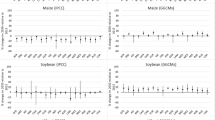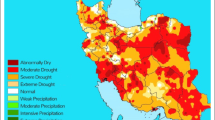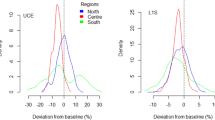Abstract
Agricultural sectors play a key role in the economics of climate change. Land as an input to agricultural production is one of the most important links between economy and the biosphere, representing a direct projection of human action on the natural environment. Agricultural management practices and cropping patterns exert an enormous effect on biogeochemical cycles, freshwater availability and soil quality. Agriculture also plays an important role in emitting and storing greenhouse gases. To consistently investigate climate policy and future pathways for the economic and natural environment, a realistic representation of agricultural land use is essential. Top—down Computable General Equilibrium (CGE) models have increasingly been used for this purpose. CGE models simulate the simultaneous equilibrium in a set of interdependent markets, and are especially suited to analyze agricultural markets from a global perspective. However, modeling agricultural sectors in CGE models is not a trivial task, mainly because of differences in temporal and geographic aggregation scales. This study surveys some proposed modeling strategies and highlights different tradeoffs involved in the various approaches. Coupling of top-down and bottom-up models is found to be the most applicable for comprehensive analysis of agriculture in prism of climate change. However, linking interdisciplinary data, methods and outputs is still the major obstacle to be solved for wide-scale implementation.


Similar content being viewed by others
Explore related subjects
Discover the latest articles and news from researchers in related subjects, suggested using machine learning.Notes
MtC-eq/yr are millions of tons of carbon equivalent GHG per year, with global warming potentials of methane, nitrous oxide and other GHG other than carbon dioxide, used as conversion coefficients for non-CO2 gases.
For a review of carbon sequestration in terrestrial ecosystems, see http://csite.esd.ornl.gov.
See Hubacek and van den Bergh (2006) for a review of changing concepts of land in economic theory.
In standard GTAP model CET of land transformation equals −1.
References
Abdula R (2005) Climate change policy of bio-energy: a computable general equilibrium analysis. Paper presented at the International Conference on Energy, Environment and Disasters, Charlotte, NC, USA, July 24–30
Alcamo J, Leemans R, Kreileman E (eds) (1998) Global change scenarios of the 21st century: results from the Image 2.1 Model. Elsevier Science, The Netherlands
Baltzer K, Kløverpris J (2008) Improving the land use specification in the GTAP Model IFS working paper 2008–2. Institute of Food and Resource Economics, Denmark
Banse M, Grethe H (2008) Top down, and a little bottom up: modelling EU agricultural policy liberalization with LEITAP and ESIM. Paper presented at the GTAP Conference, Helsinki, Finland, June 12–14
Berrittella M, Hoekstra AY, Rehdanz K, Roson R, Tol RSJ (2007) The economic impact of restricted water supply: a computable general equilibrium analysis. Water Res 42:1799–1813
Bosello F, Zhang J (2005) Assessing climate change impacts: agriculture. FEEM Working Paper, 94
Brooks J, Dewbre J (2006) Global trade reforms and income distribution in developing countries. Journal of Agricultural and Development Economics 3(1):86–111
Bruinsma J (ed) (2003) World agriculture: towards 2015/2030. FAO, London: Earthscan
Burniaux JM (2002) Incorporating carbon sequestration into CGE models: A prototype GTAP model with land uses. GTAP Resource 1144. Center for Global Trade Analysis, Department of Agricultural Economics, Purdue University, Indianapolis, USA
Burniaux JM, Lee HL (2003) Modelling land use changes in GTAP. Paper presented at the Sixth Annual Conference on Global Economic Analysis. The Hague, The Netherlands, June 12–14
Darwin R, Tsigas M, Lewandrowski J, Raneses A (1995) World agriculture and climate change: Economic adaptations. Agricultural Economic Report 703. Natural Resources and Environment Division, Economic Research Service, US Department of Agriculture, Washington DC
Darwin R, Tsigas M, Lewandrowski J, Raneses A (1996) Land use and cover in ecological economics. Ecol Econ 17:157–181
Golub A, Hertel TW, Lee HL, Ramankutty N (2006) Modeling land supply and demand in the long run. Paper presented at the Ninth Annual Conference on Global Economic Analysis, Addis Ababa, Ethiopia, June 15–17
Golub A, Hertel TW, Sohngen B (2009) Land use modeling in recursively-dynamic GTAP framework. In: Hertel TW, Rose S, Tol RSJ (eds) Economic analysis of land use in global climate change policy. Routledge, Abingdon
Gurgel A, Reilly JM, Paltsev S (2007) Potential land use implications of a global biofuels industry. J Agr Food Ind Organ 5(2) Article 9
Hertel TW (1997) Global trade analysis. Cambridge University Press, Cambridge
Hertel TW, Tsigas ME (1988) Tax policy and U.S. agriculture: a general equilibrium approach. Am J Agr Econ 70(2):289–302
Hertel TW, Lee HL, Rose S, Sohngen B (2009a) Modeling land-use related greenhouse gas sources and sinks and their mitigation potential. In: Hertel TW, Rose S, Tol RSJ (eds) Economic analysis of land use in global climate change policy. Routledge, Abingdon
Hertel TW, Rose S, Tol RSJ (2009b) Land use in computable general equilibrium models: an overview. In: Hertel TW, Rose S, Tol RSJ (eds) Economic analysis of land use in global climate change policy. Routledge, Abingdon
Hsin H, van Tongeren F, Dewbre J, van Meijl H (2004) A new representation of agricultural production technology In GTAP. Paper presented at the 7th Annual Conference on Global Economic Analysis, Washington DC, USA, June 17–19
Hubacek K, van den Bergh JCJM (2006) Changing concepts of land in economic theory: from single to multi-disciplinary approaches. Ecol Econ 56:5–27
Ianchovichina E, McDougall R (2001) Structure of dynamic GTAP. Center for Global Trade Analysis, Technical Paper 17
Ianchovichina E, Darwin R, Shoemaker R (2001) Resource use and technological progress in agriculture: a dynamic general equilibrium analysis. Ecol Econ 38:275–291
Ignaciuk AM (2006) Economics of multifunctional biomass systems. PhD dissertation, Wageningen University, The Netherlands
IMAGE team (2001) The IMAGE 2.2 implementation of the SRES scenarios: A comprehensive analysis of emissions, climate change and impacts in the 21st century. RIVM CD-ROM publication 481508018, National Institute for Public Health and the Environment, Bilthoven, The Netherlands
IPCC (1997) Revised 1996 IPCC guidelines for national inventories. Reference Manual for Agriculture. NGGIP Publication
IPCC (2001) Climate change 2001. Third Assessment Report of the IPCC. Cambridge University Press
IPCC (2007) Climate change 2007: mitigation of climate change. Fourth Assessment Report of the IPCC.Cambridge University Press
Jorgenson DW, Wilcoxen PJ (1990) Environmental regulation and U.S. economic growth. The Rand Journal 21(2):314–340
Keeney R, Hertel TW (2005) GTAP-AGR: a framework for assessing the implications of multilateral changes in agricultural policies. GTAP Technical Paper 24
Klijn JA, Vullings LAE, van den Berg M, van Meijl H, van Lammeren R, van Rheenen T A, Veldkamp, Verburg PH (2005) The EURURALIS study: technical document. Alterra-rapport 1196., Alterra, Wageningen
Lee HL (2004) Incorporating agro-ecological zoned data into the GTAP Framework. Paper presented at the Seventh Annual Conference on Global Economic Analysis, The World Bank, Washington DC, USA, June 17–19
Lee HL, Hertel TW, Rose S, Avetisyan M (2009) An integrated global land use data base for CGE analysis of climate policy options. In: Hertel TW, Rose S, Tol RSJ (eds) Economic analysis of land use in global climate change policy. Routledge, Abingdon
McKibbin WJ, Sachs JD (1991) Global linkages: macroeconomic interdependence and cooperation in the world economy. The Brookings Institution, Washington
McKibbin WJ, Wang Z (1998) The G-cubed (Agriculture) model: a tool for analyzing US agriculture in a globalizing world. Brooking Discussion Papers in International Economics, 139
McKibbin WJ, Wilcoxen P (1998) The theoretical and empirical structure of the GCUBED model. Econ Model 16(1):123–148
Robidoux B, Smart M, Lester J, Beausejour L (1989) The agriculture expanded getmodel: Overview of Model Structure. Unpublished, Department of Finance, Ottawa, Canada
Ronneberger K, Berrittella M, Bosello F, Tol RSJ (2009) KLUM@GTAP: Spatially-explicit, biophysical land use in a computable general equilibrium model. In: Hertel TW, Rose S, Tol RSJ (eds) Economic analysis of land use in global climate change policy. Routledge, Abingdon
Sohngen B, Mendelsohn R (2006) A sensitivity analysis of carbon sequestration. In: Schlezinger M (ed) Human-induced climate change: an interdisciplinary assessment. Cambridge University Press, Cambridge
Stern N (ed) (2006) The economics of climate change: the stern review. H.M. Treasury, UK
Tan G, Shibasaki R, Matsumora K, Rajan KS (2003) Global research for integrated agricultural land use change modeling. Asia GIS Conference 2003 Publications. Wuhan Science and Technology Conference and Exhibition Center
van Meijl H, van Rheenen T, Tabeau A, Eickhout B (2006) The impact of different policy environments on agricultural land use in Europe. Agric Ecosyst Environ 114(1):21–38
Wong GY, Alavalapati JRR (2003) The land-use effects of a forest carbon policy in the US. Forest Pol Econ 5:249–263
Author information
Authors and Affiliations
Corresponding author
Additional information
This paper has been produced within the framework of the project CIRCE—Climate Change and Impact Research: the Mediterranean Environment, contract N. 036961, funded by the European Commission within the Sixth Framework Programme
Rights and permissions
About this article
Cite this article
Palatnik, R.R., Roson, R. Climate change and agriculture in computable general equilibrium models: alternative modeling strategies and data needs. Climatic Change 112, 1085–1100 (2012). https://doi.org/10.1007/s10584-011-0356-6
Received:
Accepted:
Published:
Issue Date:
DOI: https://doi.org/10.1007/s10584-011-0356-6




